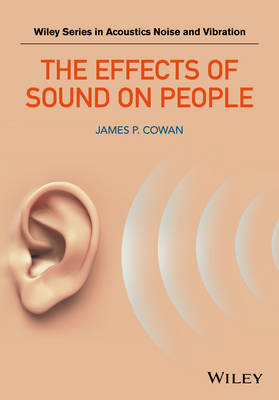
The Effects of Sound on People
John Wiley & Sons Inc (Verlag)
9781118895702 (ISBN)
- Titel z.Zt. nicht lieferbar
- Versandkostenfrei
- Auch auf Rechnung
- Artikel merken
Provides a summary of current research results on the physiological and psychological effects of sound on people
Covers how the operation of the hearing mechanism affects our reactions to sounds
Includes research results from studies on noise sources of public concern such as transportation, public utility, and recreational sources, with emphasis on low frequency sound and infrasound
Covers sounds that affect some but not others, how sounds can be controlled on a practical level, and how and what sounds are regulated
Includes coverage of both positive and negative effects of sound
James P. Cowan is a board-certified noise control engineer with more than 30 years of experience in noise control, architectural acoustics, and environmental noise issues. He has consulted to public agencies, architects, engineers, industrial personnel, and attorneys in all areas of noise control; hearing damage and protection criteria; and acoustic design of all types of spaces. Mr. Cowan has lectured on acoustical topics to thousands of professionals, delivering live seminars and webinars, and teaching courses for universities, professional societies, and private organizations across the US for more than 25 years. In addition to several book chapters and many published articles, Mr. Cowan is the author of Architectural Acoustics Design Guide, published by McGraw-Hill in 2000, Architectural Acoustics, an interactive educational CD set published by McGraw-Hill in 1999, and Handbook of Environmental Acoustics, a reference book in community noise issues published by Van Nostrand Reinhold (subsequently Wiley) in 1994.
List of Figures xi
List of Tables xiv
About the Author xv
Series Preface xvi
Preface xvii
1 Acoustic Parameters 1
1.1 Introduction 1
1.2 Sound generation 1
1.2.1 Frequency 2
1.2.2 Wavelength 4
1.3 Sound Propagation 5
1.3.1 Unimpeded divergence 6
1.3.2 Impeded Propagation 7
Reflection 8
Refraction 8
Diffraction 9
Diffusion 10
1.3.3 Sound Behavior Indoors 10
Echo 11
Room modes 11
Reverberation 13
1.3.4 Sound Behavior Outdoors 14
Atmospheric absorption 14
Atmospheric refraction 15
Ground effects 16
Vegetation effects 17
References 18
2 Sound Description 19
2.1 Introduction 19
2.2 The Decibel Scale 19
2.3 Frequency Weighting Networks 21
2.3.1 Loudness 21
2.3.2 Weighting scales 24
2.4 Frequency Band Analysis 26
2.4.1 Noise by color 28
2.5 Common Sound Descriptors 29
2.5.1 Environmental descriptors 29
2.5.2 Sound propagation in terms of sound levels 32
Divergence 32
Refraction and diffraction 33
Reverberation 33
Sound fields 34
References 35
3 Sound Perception 36
3.1 Introduction 36
3.2 Human Hearing Apparatus and mechanism 36
3.2.1 Outer ear 37
3.2.2 Middle ear 38
3.2.3 Inner ear 40
3.2.4 Signal processing in the brain 44
Localization 44
Masking and audibility 45
3.2.5 Vestibular system 46
3.3 Alternate Sound Perception Mechanisms 47
3.3.1 Bone conduction 47
3.3.2 Cartilage hearing 47
3.3.3 Tinnitus 48
3.3.4 Electromagnetic hearing 48
3.4 Hypersensitivities 49
3.4.1 Hyperacusis/misophonia 50
3.4.2 Electrohypersensitivity 50
3.5 Low‐frequency and Infrasound Perception 51
References 53
4 Physiological Effects of Sound Exposure 57
4.1 Introduction 57
4.2 Body Resonance and Damage Potential 57
4.3 Hearing Loss 59
4.3.1 Presbycusis 59
4.3.2 Noise‐induced Hearing Loss 61
4.3.3 Hearing Loss from Illness or Agents 65
4.4 Cardiovascular Disease 66
4.4.1 Hypertension 68
4.4.2 Ischemic Diseases 70
4.5 Vibroacoustic Disease 71
4.6 Low‐frequency Noise Concerns 72
4.7 Infrasound Concerns 74
References 76
5 Psychological Effects of Sound Exposure 81
5.1 Introduction 81
5.2 Annoyance 81
5.3 Stress 85
5.4 Sleep Disturbance 86
5.5 Learning Disabilities 89
5.5.1 Cognitive Development/School Performance 91
5.5.2 Office/Occupational 93
5.6 Emotional Effects 96
References 97
6 Sound Sources Associated with Negative Effects 102
6.1 Introduction 102
6.2 Transportation Sources 102
6.2.1 Roadway Traffic 104
6.2.2 Aircraft 106
Fixed wing 107
Rotary wing 108
6.2.3 Rail 109
6.3 Industry and Utilities 109
6.3.1 Power Plants 110
6.3.2 Wind Farms 111
6.3.3 Electrical Power Systems 116
6.4 Personal/Recreational Sources 116
6.4.1 Firearms 117
6.4.2 Public performances 117
6.4.3 Toys/personal Listening Devices 118
6.4.4 Appliances/Tools 119
6.5 Hums 119
6.6 Acoustic Weapons 121
References 122
7 Positive Effects of Sound 126
7.1 Introduction 126
7.2 Music Psychology 126
7.3 Sound Therapies 129
7.4 Natural Sources/Soundscapes 130
7.5 Using Sound to Influence People 133
References 136
8 Sound Control and Regulation 140
8.1 Introduction 140
8.2 Sound Control Fundamentals 140
8.2.1 Absorption 141
8.2.2 Transmission Control 143
8.2.3 Partial Barriers 149
8.2.4 Cancellation 152
8.2.5 Control at the Source 153
8.2.6 Control in the Path between the Source and Listener 154
8.2.7 Control at the Listener 156
Acoustic Privacy 157
8.3 Regulations and Guidelines 158
8.3.1 Occupational 159
8.3.2 Environmental 161
National 161
Local 165
8.4 Current and Future Research 166
References 167
Glossary 169
Index 181
| Reihe/Serie | Wiley Series in Acoustics Noise and Vibration |
|---|---|
| Verlagsort | New York |
| Sprache | englisch |
| Maße | 175 x 252 mm |
| Gewicht | 481 g |
| Themenwelt | Geisteswissenschaften ► Geschichte |
| Naturwissenschaften ► Physik / Astronomie | |
| Technik ► Maschinenbau | |
| ISBN-13 | 9781118895702 / 9781118895702 |
| Zustand | Neuware |
| Informationen gemäß Produktsicherheitsverordnung (GPSR) | |
| Haben Sie eine Frage zum Produkt? |
aus dem Bereich


